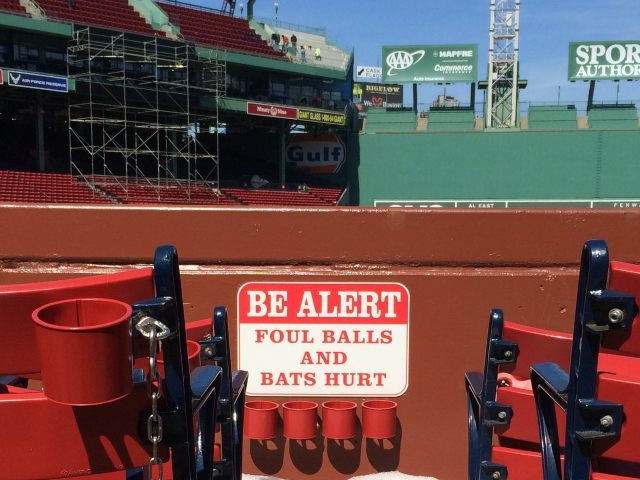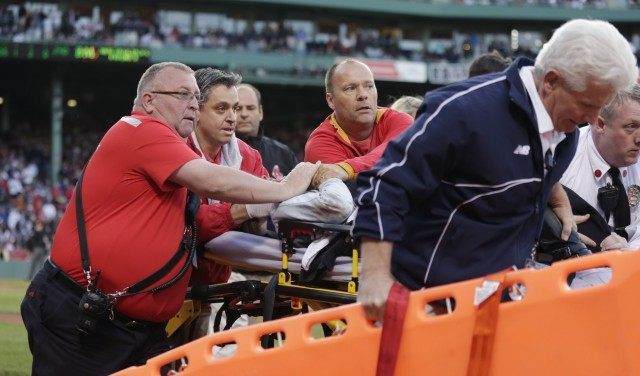Tonya Carpenter, the Paxton, Massachusetts, mom struck in the face by a broken bat at Fenway Park on Friday night, continues to improve at Beth Israel Deaconess Medical Center a short walk from the scene of her injury. Her family informed on Monday, “Tonya is responsive, and her condition has been upgraded from serious to fair.”
Nobody buys a ticket to a baseball game expecting, as the Boston Police Department characterized Carpenter’s trauma Friday night, “life threatening” injuries. But some risk, as the “Be Alert: Foul Balls and Bats Hurt” signs at the bottom of the aisles of Fenway’s lower-box seats warn, looms.
David Weeks and Robert Gorman’s Death at the Ballpark: A Comprehensive Study of Game-Related Fatalities, 1862-2007 details hundreds of fatalities in the history of a game often thought of as bucolic but rarely brutal. Fans killed by broken bats, errant balls, running players, and other threats account for more than 80 deaths in Weeks and Gorman’s book.
Twelve-year-old Ernest Seneiel, working in a Chicago can factory to support his widowed mother, took a ball to the heart watching a game in 1902. A doctor carried him to a player’s house for treatment but the boy expired before he arrived. Another 12-year-old, James Baneskiewicz, endured a foul ball to the temple on May 25, 1913. Cops arrested the 18-year-old batsman, first for manslaughter and then for breaking the Sabbath, before dropping the charges. The decedent’s grief-stricken mother was not so spared, collapsing and dying at the funeral parlor and making Seneiel’s a doubly sad duel funeral.
Death at the Ballpark overflows with sad stories. None strikes readers as so strange as the demise of a 20-year-old spectator in Morristown, Ohio. The death of Stanton Walker on October 25, 1902 illustrates the freakishness of such tragedies. Sitting between a scorer with a dull pencil and the man with a blade to sharpen it, Walker met his demise by doing what just about every fan does during every well-attended game. He acted as a go-between in relaying an object across a row. “During the course of the game,” Gorman and Weeks write, “Hyde asked Wilson for a knife so he could sharpen his pencil. Wilson opened the blade of the penknife and handed it to Walker to pass on to Hyde. Just as Walker took the knife, a foul ball struck him on the hand and drove the blade into his chest over the heart.”
Baseball is a game of timing and inches.
A small fraction of the fatalities described in Death at the Ballpark took place at Major League venues because a small fraction of baseball games take place there. MLB has endured two play-related fan deaths during its existence.
At Dodger Stadium 45 years ago, Manny Mota fouled a Gaylord Perry pitch into the stands, where the ball hit 14-year-old Alan Fish, attending the game with a chaperoned group of boys. He died four days later (Mota’s teenage nephew, playing baseball rather than watching, later died from a lightning strike).
Washington Senators owner Clark Griffith’s nephew Sherrard Robertson, derided by fellow players as the “owner’s pet, booed by fans, and lambasted by Washington Post legend Shirley Povich, didn’t help his cause with a sub-.900 fielding percentage. On September 30, 1943, the Canadian overthrew the first baseman on a routine grounder hit to third. Instead of the first baseman’s mitt, Robertson, playing in between stints in the U.S. Navy, hit 32-year-old government employee Clarence Stagemyer, fracturing his skull. The Civil Aeronautics Administration worker died the next day.
Boxing rather than baseball catalyzed the worst park tragedy in the history of the game. On August 8, 1903, a drunken fight on Fifteenth Street outside of Philadelphia’s Baker Bowl attracted a rush of spectators away from the baseball and toward the brawl. The pressure proved too much for the rotting beams supporting the wooden bleachers. Hundreds of Phillies fans fell thirty feet from the stadium to the street below. The disaster left twelve dead, three hundred injured, and the Phillies playing at nearby Shibe Park for the next 12 home games. The tragedy, at a park featuring a wall 23 feet higher than the Green Monster and witnessing Babe Ruth’s last at-bat, overshadows all else in the 51-year history of the MLB stadium.
Commissioner Rob Manfred says that he plans to reevaluate park safety measures in the wake of Friday’s horrific scene at Fenway. But new safety measures, such as extending screens up the first- and third-base lines, may meet resistance from the very fans the commissioner seeks to protect. Ticket holders pay $100 for choice seats not to be screened from the action but to be on top of it.
Very rarely does that action become deadly. The list of baseball deaths looks a lot longer around the turn of the last century than in recent decades despite the population explosion. The introduction of warning tracks, padded fences, and batting helmets eventually better protected players, and backstop screens and fences separating the players from the spectators ultimately kept fans safer.
But watching, like playing, carries a small degree of risk. “By attending the baseball game, the ticket holder assumes all risk and danger incidental to the Game,” the back of Tonya Carpenter’s ticket warned. These hazards, “including, but not limited to, the danger of being injured by equipment, objects or persons entering spectator areas,” remain, like balls, strikes, and outs, a part of the 19th-century game.


COMMENTS
Please let us know if you're having issues with commenting.